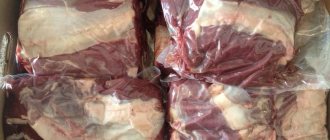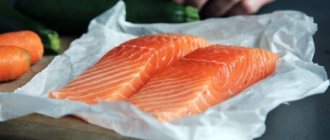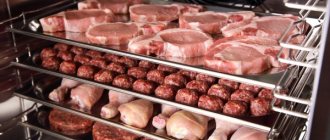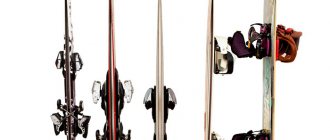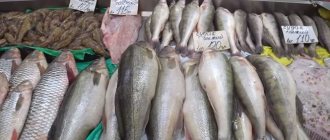Meat is a specific raw material. The characteristic features of meat are that it is a complete source of protein, has a multicomponent composition, heterogeneous structure, high biological activity and can change its characteristics when exposed to external factors.
In this regard, the production of high-quality meat products and the efficient use of raw materials are achieved through professionalism and compliance with the basic principles of production and meat storage technology.
Using refrigeration processing of meat, it can be divided into:
- Fresh meat, which is considered as such for 1.5 hours after the slaughter of the animal. The temperature in the depths of the muscle mass of such meat ranges from +25°C or more, differing slightly depending on the type of meat and part of the carcass. So, in the area of the hip part of the pork inside the muscles, the temperature of fresh meat should be at +35°C...+36°C, and for beef in the same part of the carcass (at a depth of at least 6 cm) the temperature is +36°C...+ 38°C.
- Chilled, obtained after cutting the carcass and brought using refrigeration units to a state where the temperature in the middle of the muscles is from 0 to + 4 ° C. Its surface has a small dried crust, and the muscle tissue itself is quite elastic.
- Frozen, which is subject to incomplete freezing: only the top layer is subject to it, no more than 25% of the total volume of the carcass. During transportation and storage of meat, frozen products, unlike chilled ones, are more stable and less susceptible to changes during heat treatment compared to frozen meat.
- Frozen meat is a product that has undergone freezing, as a result of which the temperature in the thickness of the muscles should not exceed -8°C. In addition to single types of mold, the development and growth of microorganisms in frozen meat is maximally inhibited, and therefore spoilage of frozen meat is eliminated.
In order to accumulate raw materials and short-term storage of meat with its simultaneous maturation, the meat is cooled, and for long-term storage of meat it is frozen. Cooling and freezing of meat is carried out in blast freezing chambers, refrigeration chambers, and low-temperature warehouses.
Preparing meat for storage
A decrease in the quality of meat, the emergence of difficulties in the technological processing of carcasses, as well as a decrease in the level of stability of meat during storage of chilled meat or frozen meat products largely depends on the primary processing of livestock, this is:
- method of slaughtering animals;
- bleeding process;
- whitening and skinning;
- scalding and hitting the bristles;
- sawing;
- wet and dry toilet.
Thus, for cattle, the mechanical stunning method is preferable to avoid internal hemorrhages and bone fractures. Compared to electrical stunning, such meat has significantly higher organoleptic (color, taste, smell) and technological (elasticity, water-binding capacity) parameters.
At the same time, it is better to stun pigs using a carbon dioxide gas mixture, the effect of which causes anesthesia in the animal, general immobility and relaxation of all muscles. This ensures productive bleeding and reduces the risk of internal hemorrhages.
Incomplete bleeding gives the meat a darker shade, as well as the likelihood of microbiological spoilage, both when storing fresh meat and chilled meat. Poor-quality whitening and skinning not only causes poor presentation due to cuts and snatches, but also allows mold and putrefactive microorganisms to penetrate into the meat, causing spoilage of the meat.
Signs of spoiled meat
https://youtube.com/watch?v=2oVtH5avZYw
Meat is considered a perishable product, so if stored in the refrigerator longer than expected, it becomes unusable. A low-quality product can be determined by three criteria:
- Appearance. The color of the fibers must match the type of meat. Typically the flesh ranges from light pink to burgundy. If it is a piece with bones and joints, they should be white. It is acceptable for the fat layer to have a yellowish tint. The product is spoiled if the pulp has multi-colored tints or a grayish tint.
- Smell. Fresh fillet has a light milky aroma. If the piece emits a sour or musty smell, the product is spoiled.
- Consistency. A fresh piece is always elastic and dense; when pressed with a finger, the fibers spring back well. If the flesh looks loose, but feels slippery and sticky to the touch, the meat is stale.
Always pay attention to all specified characteristics. If you find at least one criterion for damage, refrain from purchasing
Meat cooling methods
Even if the temperature decreases during post-mortem storage of meat, processes associated with fermentation, physical and chemical transformations in tissues continue to develop, which leads to changes in the water-binding capacity of meat, as well as its taste, smell, juiciness and consistency.
Cooling is the most common way to process fresh meat. To do this, after the initial processing, carcasses, half-carcasses or quarters are cooled hanging in freezers, for which meat hangers are used. Moreover, not only the temperature, but also the amount of air movement in different places of the chamber must be equal. To ensure that the load on the hanging tracks in the chamber does not exceed the norm, the most acceptable distance between carcasses should be from 3 to 5 cm.
Cooling of meat products in accordance with the rules for storing meat is carried out in several ways:
- In the refrigerating chamber while maintaining a constant temperature throughout the entire cooling period (temperature in the chamber is 0°C, air humidity is from 87% to 97%). The cooling time lasts from 30 to 36 hours, until the temperature inside the femur reaches +2°C ... +4°C).
- In a chamber with intensive cooling, where the process occurs faster due to lower air temperature (-8°C...-12°C), as well as increased air speed to 1-2m/s. This method allows you to cool the product several times faster: if the specified requirements are met, the temperature inside the thigh +3°C...+4°C is achieved in 6-8 hours. Since during intensive cooling there is a certain difference in the temperatures of the surface and internal layers of meat, it is sent for storage in a chamber maintaining a temperature of +2°C.
Based on the cooling time and level of meat drying, the following methods can be distinguished:
- Slow cooling, when this process occurs in refrigeration chambers at temperatures from 0°C to +3°C and air speed from 0.1m/s to 0.3m/s. The duration of cooling with this method takes from 24 to 36 hours, until the temperature in the thickness of the muscles drops to +3°C...+4°C. Moreover, shrinkage during wet cutting is 1.2% - 2.3%, and during dry cutting - 0.8% - 1.6%.
- Accelerated, which occurs at a temperature of about 0°C and an air speed of 0.5 m/s. With this method, the cooling time is reduced to 24 hours, and shrinkage is reduced to 1.5%.
- Rapid cooling is carried out in tunnel refrigeration chambers maintaining a temperature of -3°C and an air movement of 0.8 m/s. Cooling of meat to the required level is achieved in 13 hours (pork) and 16 hours (beef), and shrinkage is about 1.3%.
A slow decrease in temperature leads to the appearance of a characteristic dried crust on the carcass, which causes weight loss and reduces the functional and technological properties of the meat. Low intensity of cooling inside the muscle mass with inadequate sanitary treatment during the primary processing of pigs and livestock leads to an increase in the growth of putrefactive bacteria in the inner layers of meat, as well as to the appearance of a “tan” accompanied by an unpleasant pungent odor and unusual color.
Signs of product spoilage
At low temperatures the product can be kept for 5-7 days. The following signs indicate spoilage of a dish:
- In the refrigerator, the dish began to release water that did not set.
- A crust has formed on the product or has a gray tint.
- The jelly has become cloudy.
- In room conditions, the dish began to smell bad of spoiled meat.
If storage rules are followed, such signs may appear on days 6-7. To remember how long the product can be stored in the refrigerator, it is worth making a mark on the packaging with the date of preparation. The missing product is strictly prohibited from being consumed. It needs to be thrown away. Jellied meat is a tasty and healthy dish that has a specific shelf life. In order for the product to remain fresh for a long time, it must be provided with suitable conditions.
Share link:
Methods for freezing meat and their features
Meat, like meat products, can be frozen by various methods: in air, salt solutions, boiling refrigerants, or in direct contact with metal plates of freezing units.
The most common method of freezing meat in air comes in the form of two methods:
- Single-phase, in which fresh meat is immediately frozen.
- Two-phase, when fresh meat is first cooled to a temperature of approximately +4°C, and then frozen at -8°C and below.
The most commonly used in industry is a two-phase method for freezing cattle, pork or lamb meat. Based on the freezing speed, they are divided into:
- Slow freezing, carried out at a temperature of -18°C...-23°C, air movement at a speed of 0.1m/s - 0.2m/s and humidity of about 90%-95%. This freezing lasts about 35-40 hours.
- Intensive, carried out at a temperature of -23°С...-30°С, air speed 0.5 m/s - 0.8 m/s and humidity 90%-95% for 28 hours.
- Fast, at which the air temperature is -30°C...-35°C, the air flow speed is from 1 to 4 m/s. Freezing meat using this method lasts about 18 hours.
Freezing of meat in production is carried out in a suspended state on overhead tracks, while the most voluminous parts (thighs) are placed on top, where air flow is maximum. The distance between carcasses, half-carcasses and quarters should be within 3 - 5 cm. Contact freezing, which is performed when interacting with a surface at low temperatures, can reduce the freezing time of meat by 1.5 - 2 times. With this method, meat blocks are placed between frozen metal plates located in special freezing equipment. In this case, boneless meat weighing 25 kg is frozen for 4-5 hours (at a temperature of -35°C, brought to -8°C inside the muscles).
How to determine the freshness of meat
Before going on sale, the product is thoroughly checked for compliance with legally established norms and standards by regulatory authorities. In this case, the animal carcass is butchered at the meat processing plant according to all the rules, after which it is thoroughly washed and cleaned.
Then veterinary and sanitary control is carried out, as a result of which the meat is either allowed for sale - then a stamp of a certain type is placed on it, or it is rejected. The final stage of pre-sale preparation of a product is obtaining a quality certificate.
This is what fresh lamb looks like
The seller seeks to attract the consumer's attention by offering a beautiful-looking product. The buyer's task is to determine the freshness of the meat by assessing it according to the following criteria:
Smell
The aroma emanating from a fresh product should not be repulsive. It should be fresh and natural, without any additional impurities or shades. If the piece has a beautiful appearance, but its aroma is unpleasant, then it is better to refuse such a purchase.
Color
The shade varies depending on the type:
- pork flesh is pink-red in color and has a delicate structure with slight inclusions of veins (marble pattern);
- high-quality beef is red in color, the fat layer is light and unclouded. If the meat is “stale”, then the cut will be dark red, almost brown;
- dairy veal is bright pink with flecks of fat;
- Lamb is valued for its nutritional value and naturalness. Fresh meat has a light red tint and is generously “stuffed” with white fat.
This is what beef fillet looks like
Consistency
The freshness of the product can be checked by pressing on the pulp with a special fork, which is available at every seller. If the meat has just gone on sale, the integrity of the surface will quickly be restored, but if it has been stored for a long time, the dent will remain for a long time. In addition, the piece may seem “dry” in appearance, but if you cut it, a clear liquid will flow from the cut of the fresh product.
In order to distinguish fresh pulp from previously frozen pulp when purchasing, you also need to simply press on its surface. The product, which has not previously been frozen, is distinguished by the fact that the place of pressure smoothes out very quickly. Thawed meat has a less elastic structure, which is why the hole lasts a long time and its filling with liquid indicates that the piece has already been in the freezer.
Types of cooking meat
To preserve meat and meat products, thermal processing methods can also be used:
- hot and cold smoking;
- baking, steaming, boiling and frying meat;
- drying (dehydration) of meat.
In this case, additional methods can be used to increase the preservative properties of products, such as:
- ambassador of raw materials;
- double cooking;
- high-temperature heating at increased osmotic pressure;
- a shift towards increased acidity of the pH indicator.
The shelf life of smoked meat is 72 hours, fried and boiled meat is 48 hours. It should be taken into account that additional cooling of meat that has undergone heat treatment to +3°C...+5°C increases several times.
Heat treatment of meat can be used both for intermediate short-term storage in the absence of refrigeration equipment, and for subsequent sale as finished products.
Meat shelf life
The production of chilled meat, which is in the ripening stage and has the highest nutritional properties in comparison with frozen meat, although it is economically profitable, has its drawback - a rather short shelf life.
The maximum shelf life of chilled meat in refrigerators and freezer cases, at temperatures from 0°C to -2°C, humidity from 85% to 90% and slight air circulation (about 0.1 m/s) are:
- beef – no more than 16 days;
- pork and lamb – no more than 12 days.
Frozen (temperature -2°С…-3°С) meat can be stored for up to 20 days.
When selling meat in the form of carcasses in retail outlets at a temperature of about 0°C, meat can be stored for up to 3 days.
Freezing meat is the most commonly used method for storage because it provides a high level of preservation and a long shelf life. Despite the disadvantages of this storage method (reduction in weight and quality, high material costs), it is the most effective way for long-term storage of meat and preservation of its taste and nutritional characteristics.
At a storage temperature of frozen meat within -12°C and humidity from 95% to 98%, its shelf life is:
- beef – 8 months;
- pork – 3 months;
- lamb – 6 months.
When maintaining a temperature of -18°C in the chamber, frozen meat is stored for at least:
- beef – 13 months;
- pork – 6 months;
- lamb – 10 months.
In chambers providing a temperature of -30°C, frozen meat can be stored:
- beef – up to 2 years;
- pork – up to 15 months;
- lamb – up to 2 years.
Rabbit carcasses frozen to a temperature of -9°C and below are stored for up to 6 months. In refrigerators, meat is stored in dense stacks or in pallets in several rows.
The shelf life of meat in stores where the temperature in refrigeration equipment is about 0°C is no more than 5 days, at temperatures from 0°C to +6°C - up to 3 days, at temperatures from +6°C to +8° C – up to 2 days.
Showcases are available in built-in options: static and ventilated.
- The ventilated version of refrigerated display cases maintains the temperature in the refrigerator volume more evenly and more stable, but the airing and drying of the goods occurs more actively.
- A static refrigerator maintains the stability of the distribution of a single temperature regime in the refrigeration volume worse, but weathering and shrinkage do not occur. For meat, a static refrigerated display case is recommended, which better preserves the commercial quality of chilled meat and semi-finished meat products.
For example, you can purchase the following models of display cases for masa and semi-finished meat products (the price for these meat display cases is approximately up to 35,000 rubles):
- Showcase for meat Dvina VSN , Showcase for meat Gamma SN are acceptable options from the Gulf Stream factory.
- Display case for meat Ilet VSN
- Preserved variation of the Oberon display case, suitable for selling meat. Universal refrigerated display cases Ariada: Ophelia, for example.
Meat storage conditions
In addition to the temperature regime when storing meat, the following parameters must be observed:
- relative humidity, the value of which depends on the air temperature, but should not be lower than 85%;
- air flow circulation (must correspond to 4 to 6 air volumes per hour).
Also, when determining the terms and conditions for storing meat, one should take into account the presence or absence of packaging (vacuum, PVC film, paper, etc.), as well as the composition of the gas mixture or the use of inert gases. When storing chilled meat, free air access must be provided to it, so it should be suspended, without touching each other or the walls of the chamber.
Storing meat in a freezer at a strong temperature drop (down to -30°C...-50°C) can cause significant weight loss in the product, so in such cases an active air humidification system in the chamber is used.
Why is low-quality meat dangerous?
Eating low-quality meat can lead to infection with certain diseases. For example, enterovirus, typhoid, botulism, salmonella. Such ailments can cause poisoning and intoxication of the body. Some cases can be fatal.
You can understand that intoxication or poisoning has occurred by specific signs:
- temperature;
- nausea;
- vomit;
- diarrhea;
- fever;
- dizziness;
- sharp pain in the abdomen.
Increasing the shelf life of meat
To increase the shelf life of chilled meat, the following methods are used:
- storage in a carbon dioxide atmosphere;
- using nitrogen, ozone;
- substances are used that form a film on the surface of the meat;
- the use of antibiotics, ultraviolet radiation and radiation exposure.
The listed methods for increasing the shelf life of meat are not widely used in practice. In addition, to extend the shelf life of meat, some food acids can be used, which, in addition to bactericidal properties, improve the color of meat, its digestibility, and loosen the protein structure.
Vacuum packaging of meat extends the storage period by 2 times. Vacuum packaging is most widespread when storing chilled meat.
In conclusion, it should be noted some features that affect the quality and nutritional value of meat depending on the methods and conditions of its storage.
- Unlike frozen meat (especially that which has been quickly frozen), chilled meat has significantly greater nutritional value and increased taste. This is due to the fact that frozen meat is frozen at the stage of rigor mortis of the animal, without going through the maturation stage. Because of this, quickly frozen meat turns out to be tougher and less juicy during cooking.
- When storing frozen meat, a process of salting out a certain part of the protein occurs, which increases the concentration of salts in the muscles due to freezing of water, and the solubility of proteins is lost.
- By extending the shelf life of frozen meat, protein hydration decreases, which causes loss of meat juice during defrosting of meat.
- Meat stored at a temperature of -18°C for 2 years loses 2.5 times more juice during defrosting than meat stored for 4 months.
How to choose chilled meat
In order not to be mistaken with the quality of meat, you need to carefully consider its choice. Firstly, color is important. If the beef is too light, then this is a reason to be wary, as this is an indicator of the animal being too young. Such people are not allowed to be slaughtered without compelling reasons. Meat that is too dark, with a gray tint, indicates that it is not fresh. If chilled beef meat has yellow and dull fat, you should refuse such a purchase.
Fresh, high-quality meat has an elastic consistency and a shiny surface; moisture does not leak out of it, and there is no plaque on it.
To check this, you should take the piece in your hands and carefully examine it from all sides. Then you need to press your finger on the surface, if the resulting depression quickly disappears, then the meat has not been frozen. Thawed meat is characterized by looseness, the muscles are not elastic, and ichor may drip from it. Freshness will help determine the smell. It should not be harsh and unpleasant, causing negative emotions.
Remember, the older the cow, the more fatty layers there are in its meat. In a young individual they are barely noticeable.
With the right choice and compliance with all storage standards, it is possible to prepare a delicious dish using meat that will be safe for health and beneficial for the body.
